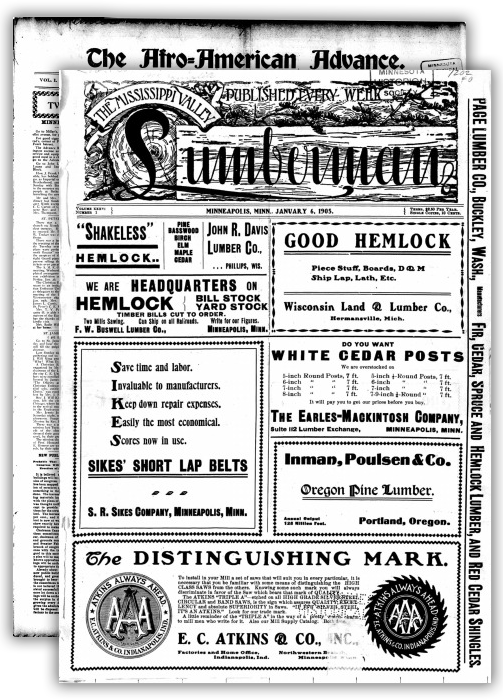
hub
Introduction
titles
About the titles
corporations foundations
Search the Newspapers
hub-faq
F.A.Q.
Choose a Menu
-
hubIntroduction
-
titlesAbout the titles
-
corporations foundationsSearch the Newspapers
-
hub-faqF.A.Q.
Rochester Post
The Rochester city post (Rochester, Minn.) 1859-1866 Browse the title
The Rochester post (Rochester, Minn.) 1866-1899 Browse the title
State Fair post (Rochester, Minn.) 1867 Browse the title
The city of Rochester lies along both banks of the Zumbro River in southeastern Minnesota. It was declared the county seat of Olmsted County in 1857 because of its expansive agricultural economy, especially in wheat. Rochester’s role as a major thoroughfare for agricultural trade and transport grew when the Winona to St. Peter railroad line was established in 1864. The devastation caused by a fatal tornado on August 21, 1883 eventually gave rise to what would become the Mayo Clinic. Rochester is now an important medical care and research community, recognized globally.
Some of the earliest newspapers of southern Minnesota were published in Rochester. David Blakely and his brother, Cyrene H. Blakely, began publishing the Rochester City Post as the Blakely Brothers in 1859. Beginning with a six column, four page paper, the Blakelys provided the citizens of Rochester "…[a] weekly newspaper devoted to the dissemination of pure literature, correct agricultural statistics and market reports, late news, foreign and local, and…true Republican principles." Their coverage of the American Civil War centered around reporting the latest military movements and printing the correspondence from reporters sympathetic to the Union stationed throughout the northern and southern states. While the Blakelys’ earlier experiments in publishing the Bancroft Pioneer and the Austin Minnesota Mirror were short-lived, the Rochester City Post was circulated until it was sold to the Leonard and Booth firm in late 1865.
Joseph A. Leonard and Walter S. Booth continued publishing the Rochester City Post as the Rochester Post with the motto, "The Official Paper of the City and County." They kept the original Saturday distribution date, but enlarged the paper to eight pages. It remained a platform for Republican Party politics, and gave ample space to agricultural news and advertising. The publishers also circulated a daily exhibition edition called the State Fair Post, extant issues of which exist for October 1, 2, 3 and 4, 1867 when the Minnesota State Fair was held in Rochester. Within the first few years of circulation, the firm expanded their print shop by purchasing the Rochester Republican and publishing the first Scandinavian newspaper west of the Mississippi, titled the Rochester Nordisk Folkeblad. After the retirement of Booth some years earlier, Leonard was appointed United States consul to Scotland in 1881. After his appointment, Leonard left the paper in the hands of its long-time printer, Lewis H. Kelley. Leonard, excluding a brief period in the late 1880s, would not return to the paper until 1893.
Under the management of the Kelley Brothers, Lewis Kelley and his brother P. S. Kelley of the Faribault Democrat, a daily complement to the Rochester Post was established, titled the Rochester Daily Leader. The daily newspaper had seven columns, and four pages of national and world news, local announcements and advertisements, market reports, serial fiction, and Republican Party politics. The Rochester Daily Leader changed its name to the Rochester Daily Post in 1893 and continued to run alongside its weekly counterpart until Leonard sold his papers to Amherst W. Blakely. Merging the Rochester Post with the Record and Union, Blakely began publishing the weekly Rochester Post and Record and the Daily Post and Record in 1899.
Minnesota Digital Newspaper Hub
The Minnesota Digital Newspaper Hub is a searchable website from the Minnesota Historical Society that makes millions of pages of Minnesota newspapers available online.
The Hub contains geographically and culturally diverse newspapers published between 1849 and today. Due to potential copyright restrictions most issues published after 1977 can only be accessed from the Gale Family Library at the Minnesota History Center.
The Minnesota Digital Newspaper Hub incorporates Minneapolis Tribune titles previously found on a stand-alone website, foreign-language titles, and much more, with new titles and date ranges continuously being added.
The Minnesota Historical Society's newspaper digitization program is made possible through support from the National Endowment for the Humanities and the National Digital Newspaper Program (NDNP), the Legacy Amendment's Arts and Cultural Heritage Fund through the vote of Minnesotans on Nov. 4, 2008, SELCO (Southeastern Libraries Cooperating) through a grant from the Minnesota Arts and Cultural Heritage Fund for Libraries, and many other organizations and individual donors.
Material in the Digital Newspaper Hub may be protected by copyright law (U.S. Code Title 17).
Looking for more information on MNHS digital newspaper collections? Visit Digital Newspapers at MNHS
